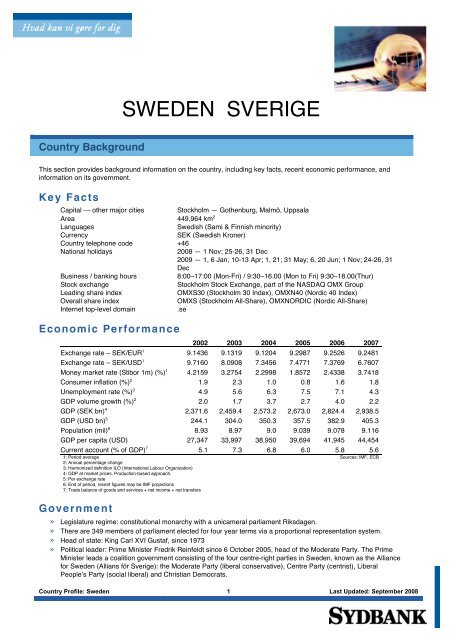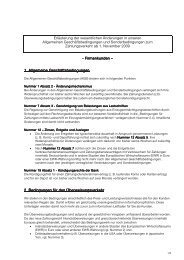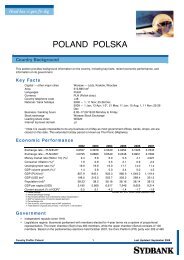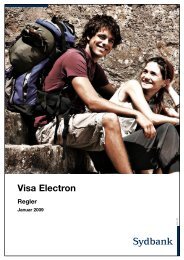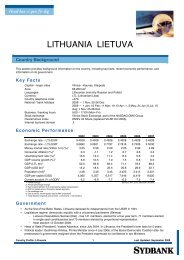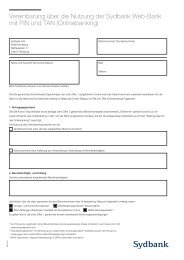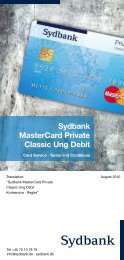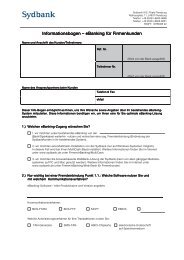SWEDEN SVERIGE - Sydbank
SWEDEN SVERIGE - Sydbank
SWEDEN SVERIGE - Sydbank
Create successful ePaper yourself
Turn your PDF publications into a flip-book with our unique Google optimized e-Paper software.
Country Background<br />
<strong>SWEDEN</strong> <strong>SVERIGE</strong><br />
This section provides background information on the country, including key facts, recent economic performance, and<br />
information on its government.<br />
Ke y Facts<br />
Capital ⎯ other major cities Stockholm — Gothenburg, Malmö, Uppsala<br />
Area 449,964 km 2<br />
Languages Swedish (Sami & Finnish minority)<br />
Currency SEK (Swedish Kroner)<br />
Country telephone code +46<br />
National holidays 2008 — 1 Nov; 25-26, 31 Dec<br />
2009 — 1, 6 Jan; 10-13 Apr; 1, 21; 31 May; 6, 20 Jun; 1 Nov; 24-26, 31<br />
Dec<br />
Business / banking hours 8:00–17:00 (Mon-Fri) / 9:30–16.00 (Mon to Fri) 9:30–18.00(Thur)<br />
Stock exchange Stockholm Stock Exchange, part of the NASDAQ OMX Group<br />
Leading share index OMXS30 (Stockholm 30 Index), OMXN40 (Nordic 40 Index)<br />
Overall share index OMXS (Stockholm All-Share), OMXNORDIC (Nordic All-Share)<br />
Internet top-level domain .se<br />
Economic Pe rformance<br />
2002 2003 2004 2005 2006 2007<br />
Exchange rate – SEK/EUR 1 9.1436 9.1319 9.1204 9.2987 9.2526 9.2481<br />
Exchange rate – SEK/USD 1 9.7160 8.0908 7.3456 7.4771 7.3769 6.7607<br />
Money market rate (Stibor 1m) (%) 1 4.2159 3.2754 2.2998 1.8572 2.4338 3.7418<br />
Consumer inflation (%) 2 1.9 2.3 1.0 0.8 1.6 1.8<br />
Unemployment rate (%) 3 4.9 5.6 6.3 7.5 7.1 4.3<br />
GDP volume growth (%) 2 2.0 1.7 3.7 2.7 4.0 2.2<br />
GDP (SEK bn) 4 2,371.6 2,459.4 2,573.2 2,673.0 2,824.4 2,938.5<br />
GDP (USD bn) 5 244.1 304.0 350.3 357.5 382.9 405.3<br />
Population (mil) 6 8.93 8.97 9.0 9.039 9.078 9.116<br />
GDP per capita (USD) 27,347 33,997 38,950 39,694 41,945 44,454<br />
Current account (% of GDP) 7 5.1 7.3 6.8 6.0 5.8 5.6<br />
1: Period average<br />
2: Annual percentage change<br />
3: Harmonized definition ILO (International Labour Organization)<br />
4: GDP at market prices. Production-based approach.<br />
5: Per exchange rate<br />
6: End of period, recent figures may be IMF projections<br />
7: Trade balance of goods and services + net income + net transfers<br />
Gove rnme nt<br />
Sources: IMF, ECB<br />
» Legislature regime: constitutional monarchy with a unicameral parliament Riksdagen.<br />
» There are 349 members of parliament elected for four year terms via a proportional representation system.<br />
» Head of state: King Carl XVI Gustaf, since 1973<br />
» Political leader: Prime Minister Fredrik Reinfeldt since 6 October 2005, head of the Moderate Party. The Prime<br />
Minister leads a coalition government consisting of the four centre-right parties in Sweden, known as the Alliance<br />
for Sweden (Allians för Sverige): the Moderate Party (liberal conservative), Centre Party (centrist), Liberal<br />
People’s Party (social liberal) and Christian Democrats.<br />
Country Profile: Sweden 1 Last Updated: September 2008
» Next election due September 2010.<br />
» Member of the European Union: Since 1995. Sweden rejected the adoption of the euro via referendum in 2003.<br />
Legal and Regulatory Issues<br />
This section provides information on the country’s legal and regulatory issues, including legislation, resident and nonresident<br />
status, account ownership, cash pooling regulations, account types and charges, FX controls, central bank<br />
reporting requirements, anti-money laundering, and electronic transactions.<br />
Ove rvie w<br />
» Under the European Single Market’s objective of free movement of capital the Swedish financial environment and<br />
the rules regulating it have been harmonised with the rest of the EU, e.g. within money laundering.<br />
» As such the market for financial services is deregulated.<br />
Ce ntral Bank Re porting<br />
» No central bank reporting requirements for transactions between residents and non-residents apply for<br />
corporations.<br />
» However, Riksbanken (the central bank) can request that the banks report residents’ transactions with nonresidents,<br />
subject to that such reporting is necessary for Riksbanken in order to follow the development on the FX<br />
market and to establish balance of payments.<br />
» Nonetheless, the Swedish Tax Authority (Skatteverket) has taken over the reporting of all international payments<br />
above SEK 150,000.<br />
» Banks must report all transactions above this limit, and the banks’ customers need to inform the tax authorities<br />
(via the bank) of the transaction’s purpose.<br />
» It is not the banks responsibility to check the validity of the information received.<br />
» Reporting is done annually.<br />
Re side nt and Non-re side nt Status<br />
» To be legally regarded as a resident company, the company must be registered with Bolagsverket (the Swedish<br />
Companies Registration office).<br />
Account Owne rship<br />
» Any type of account can be owned by a resident as well as a non-resident company.<br />
Cash Pooling Re gulations<br />
» Domestic and cross-border cash concentration is allowed.<br />
» Notional pooling is allowed domestically and on a cross-border basis.<br />
» Swedish banks are not allowed to off-set credit and debit balances for the purpose of calculating their Capital<br />
Adequacy Ratio. Hence, a spread between the debit and credit interest rate will be applied.<br />
» Cash pooling across legal entities, but within the same group, is permitted. Nevertheless, the Swedish Company<br />
Act applies certain restrictions.<br />
» Resident and non-resident companies can participate in the same cash pool subject to approval from The<br />
Riksbank. Standard practice is that approval will be granted if the companies are incorporated within the<br />
European Economic Area (EEA).<br />
» Swedish legislation permits multicurrency cash pooling.<br />
Account Type s and Charge s<br />
» Current accounts can be held in all exchangeable currencies and are offered with or without overdraft limits<br />
Country Profile: Sweden 2 Last Updated: September 2008
» SEK accounts are convertible into foreign currency.<br />
» Interest rates can be either fixed using a base rate of the bank or based on a market rate ⎯ e.g. the inter-bank<br />
rate, STIBOR ⎯ less a spread. For larger corporations the latter method is the most common.<br />
» Account maintenance fees (or similar) applies.<br />
» Lifting fees (per mille of transferred amount) does usually not apply.<br />
» A flat fee will be charged for domestic payments ⎯ a per mille charge (see above) could be charged for foreign<br />
payments, but the standard is a flat fee as well.<br />
» In accordance with EU rules (Regulation 2560/2001) on cross-border payments in euro, payments/transfers with<br />
the EU and certain EFTA countries cost the same as their domestic equivalent.<br />
– EU standard transfers can only be undertaken exclusively in euro<br />
– The maximum amount of EUR 50,000 should not be exceeded<br />
– The payment must be credited to an account maintained in a EU state (or certain EFTA countries)<br />
– The IBAN and the BIC of the recipient must be correctly indicated<br />
– Transfer fees shall be divided between the sender and the recipient (each pays the fees incurred in her/his<br />
corresponding country).<br />
– Note: orders not fulfilling these requirements will be carried out as foreign transfers and charged<br />
accordingly.<br />
FX Controls<br />
» The Swedish Krone flows freely.<br />
» The Riksbank can intervene or coordinate an intervention with other European Central Banks in order to stabilise<br />
the exchange rate.<br />
» There are no exchange controls.<br />
Anti-Mone y Launde ring<br />
» The EC Money Laundering Directive (Council Directive 91/308/EEC of 10 June 1991 as amended by directive<br />
2001/97/EC of 4 December 2001) has been implemented in Sweden. Generally, all the legislation is based on the<br />
40 recommendations of FATF (Financial Action Task Force on money laundering).<br />
» The headlines of the Money Laundering Regulations are:<br />
– The banks must put adequate internal security and control systems against money laundering in place,<br />
– Adherence to identification procedures. Any person must produce satisfactory evidence of his identity<br />
when entering into a business relationship with a bank or when carrying out one-off transactions in excess<br />
of 15,000 EUR.<br />
– Take measures to ensure that the banks understand the economical background of the current business<br />
and account relationship with the customers; and<br />
– Record-keeping procedures. A record must be kept for 5 full calendar years containing a copy of the<br />
evidence of identity and details relating to all transactions carried out.<br />
» The “Third Directive” replaces existing EU legislation and incorporates into EU law the June 2003 revision of the<br />
Forty Recommendations of the Financial Action Task Force (FATF).<br />
– The National Commission of Inquiry on Money Laundering and Financing of Terrorism, appointed by the<br />
Swedish Government, has issued a report setting out its conclusions on how the Third Directive should be<br />
implemented. Stakeholders have submitted their comments on the Commission's conclusions as part of<br />
the legislative referral process.<br />
– At present these comments and the Commission's conclusions are being processed by the Swedish<br />
Government, and then a legislative proposal will be drawn up. According to the present timetable, a<br />
legislative proposal will be ready for examination by the Swedish Council on Legislation during the<br />
summer 2008 and a Government Bill will be brought before the Swedish Parliament in autumn 2008 for<br />
implementation by late 2008.<br />
Ele ctronic Transactions<br />
» Electronic invoices and electronic signatures are allowed. Sweden has implemented the EU Directive on<br />
electronic signatures into national law.<br />
Country Profile: Sweden 3 Last Updated: September 2008
The Banking Environment<br />
This section includes an overview of the banking market, market dominant banks and background information regarding<br />
the central bank and it's tasks.<br />
Ove rvie w<br />
» There are four main types of banks on the Swedish market: domestic commercial banks (joint stock banks),<br />
foreign banks, savings banks and co-operative banks.<br />
» Commercial and foreign banks have rapidly increased in numbers from 15 to 54 in just over 10 years primarily<br />
because of the entrance of new niche banks (most, purely internet-based) along with the fact that some savings<br />
banks have converted their corporate status to commercial banks. Swedbank (previously FöreningsSparbanken)<br />
has been a facilitator for this; the bank now holds shares in a number of former savings banks. Traditionally, the<br />
group of savings banks have used it as a partner to provide generic products and technical solutions.<br />
» As of September 2008 Sweden had 127 banks, of which there are 29 Swedish commercial banks, 31 foreign<br />
commercial banks, 65 savings banks, and 2 co-operative banks.<br />
» The majority of the foreign banks focus on the corporate and institutional market.<br />
» Generally speaking the Swedish banking industry is somewhat consolidated, however, being a part of the larger<br />
Nordic banking market, which has only seen a few large scale cross-border mergers, leaves open to speculation<br />
how further Nordic consolidation will affect the Swedish market<br />
» The Basel II framework, based on EU directives adopted in June 2006 and numerous interpretation guidelines<br />
issued by the Committee of European Banking Supervisors, entered into force in 2007. However, the framework<br />
will not be adopted simultaneously in all banks, as individual banks may choose not to introduce the new rules<br />
until the beginning of 2008.<br />
Marke t Dominant Banks<br />
» The sector is dominated by the “big four” Swedish banks: Handelsbanken, Nordea, SEB and Swedbank<br />
(previously FöreningsSparbanken). Amid the trend in other European countries the 4 major banks have over the<br />
past decade expanded within non-core banking activities like mortgage lending and life insurance to become<br />
financial conglomerates.<br />
» Two other Nordic financial groups with a strong position in Sweden are Danske Bank and Skandia, the market<br />
leading life insurance company.<br />
» In terms of total assets, the “big four” commercial banks plus Danske Bank cover more than 80% of the market.<br />
» The major domestic cash management banks are Nordea Bank, SEB, Svenska Handelsbanken and Swedbank.<br />
Some of the major international cash management banks have also a presence in Sweden.<br />
The Ce ntral Bank<br />
» Svergies Riksbank or Riksbanken, the central bank is an authority under the Swedish parliament. Riksbanken,<br />
founded in 1668 and considered to be the oldest central bank in the world, only gained its political independence<br />
on 1 January 1999.<br />
» Riksbanken has the sole responsibility for monetary policy and “shall make its own, independent assessments<br />
and must not take instructions from any party”.<br />
» Its main tasks are to maintain price stability and to promote a safe and efficient payment system. Riksbanken’s<br />
interprets price stability to mean low and stable inflation, concurrently with the consumer price index (CPI)<br />
maintained at around 2 per cent per annum with a specified tolerance margin of plus/minus one percentage point.<br />
The bank’s main tool for influencing inflation is the repo rate.<br />
» It also manages gold and foreign exchange reserves and has a monopoly within the supply of banknotes.<br />
» In addition, the bank supervises the Stockholm Stock Exchange’s role as central counterparty and clearing<br />
organisation, monitors clearing and settlement of securities through VPC (The Central Securities Depository), and<br />
it oversees the functionality and risks in the Bankgirot system (clearing of low-value payments).<br />
» The Central Bank takes part in Continuous Link Settlement by providing settlement accounts in SEK and by<br />
participating in the oversight of CLS.<br />
Country Profile: Sweden 4 Last Updated: September 2008
» Sweden is ⎯ like any other EU-member state ⎯ part of the European System of Central Banks (ESCB), but not<br />
a part of the ERM2-system.<br />
Financial Authorities<br />
This section includes information on key financial authorities and the country’s banking association.<br />
Ministry of Finance<br />
» The Ministry of Finance has the ultimate supervisory and legislative responsibility within banking, securities and<br />
insurance.<br />
» It is the Ministry’s goal to promote an efficient and stable financial system and to ensure the protection of the<br />
consumers’ rights. Further, by doing so the development and the competition of the financial industry should be<br />
sustained.<br />
» The Swedish Financial Supervisory Authority is an institution under the authority of the Ministry.<br />
Swe dish Financial Supe rvisory Authority<br />
» The Swedish Financial Supervisory Authority’s (Finansinpektionen, FI), overall goal is to “to promote stability and<br />
efficiency in the financial system as well to ensure effective consumer protection”.<br />
» The tasks of the Swedish FSA include:<br />
– Supervision of around 3,700 banks and other credit institutions, insurance companies, authorised<br />
marketplaces and organisations on the securities market, e.g., audits and analyses;<br />
– Issuance of licenses and permits;<br />
– Regulation and guidelines; and<br />
– Oversight of insider trades.<br />
» The authority’s vision is to:<br />
– Prevent financial crises in the marketplace; and<br />
– Ensure consumers’ and corporates’ access to a variety of services in a well functioning market.<br />
Swe dish Banke rs Association<br />
» The Swedish Bankers’ Association (Svenska Bankföreningen) has 27 member companies: 21 banks (of which 11<br />
are foreign), 3 finance companies and 3 credit institutions.<br />
» The Association represents the public interests of the banking industry and publishes information about the banks<br />
and their positions in Sweden.<br />
» Other assignments involve acting as negotiators with authorities and the government, and representing the<br />
industry internationally, mainly in the European Banking Federation.<br />
» Major banks in Sweden are represented in the Management Group (“Styrelsen”), which is elected for a 3 year<br />
period.<br />
Association for Savings Banks<br />
» The Association for Savings Banks (Sparbankers Riksförbund) represents the 66 savings banks and 8 joint-stock<br />
banks (i.e. commercial) that were once savings banks.<br />
Clearing Systems<br />
This section provides an overview of the different clearing systems in operation and includes information about each<br />
system such as transaction types, operating hours and clearing cycle details.<br />
Country Profile: Sweden 5 Last Updated: September 2008
Ove rvie w<br />
» There are three main payment systems in Sweden — RIX, Bankgirot and Data Clearing. RIX is Sweden’s<br />
national interbank RTGS system, owned and operated by the Riksbank.<br />
» Bankgirot is administered and operated by Bankgirocentralen (BGC). Data Clearing meanwhile is owned by the<br />
Swedish Bankers’ Association and operated by the BGC. The BGC, alongside 19 other automated clearing<br />
houses (ACHs) in the EEA, belongs to the EACHA (European Automated Clearing House Association).<br />
» PlusGirot, the payment system of the Swedish Post Office (Posten), was purchased from Posten by the Nordea<br />
Group in 2001 as part of its acquisition of Postgirot Bank. Previously known as Postgirot, PlusGirot is now an<br />
internal payment system for transfers in SEK and EUR between postal giro (post office) accounts held at Nordea<br />
Bank. All post office branches have access to the PlusGirot network. PlusGirot payments are often utility bill<br />
payments, government payments or salary payments. PlusGirot accounts can accept Bankgirot payments.<br />
» In addition, since the adoption of SEK in the Continuous Link Settlement (CLS) system, mainly used for FX<br />
trading, in September 2003, the majority of all FX trading in SEK is settled via the commercial banks’ accounts in<br />
the Riksbank.<br />
» A special settlement method applies for settlement of securities. The VPC (The Central Securities Depository)<br />
can transact directly on special payment accounts in RIX, whereas the members of RIX can transfer liquidity<br />
between their normal RIX accounts and these payment account.<br />
High Value Cle aring – RIX<br />
» The Riksbank’s large-value payment system RIX can be described as the hub of Sweden’s payment system, in<br />
that it handles all Swedish krona payments between banks and other players.<br />
» RIX is Riksbanken’s RTGS system for settling SEK payments, primarily between banks.<br />
» At present, work is underway in the Riksbank in implementing a new technical system and a new platform for the<br />
payment system.<br />
» Real-time settlement means that payments are settled individually and instantly and the transferred funds are<br />
immediately available on the recipient’s account.<br />
» Payments due to the Riksbank’s own transactions with participants, e.g. from securities trading and the provision<br />
of bank notes are also settled through RIX.<br />
» Participants: 22 direct participants including the Riksbank. Other banks (indirect participants) clear through the<br />
direct participants.<br />
– Requirements for participation: To participate in RIX an institution does not have to be domiciled or have a<br />
branch in Sweden. Further, the participants must fulfil technical and capital adequacy requirements.<br />
» Transaction types: Individual, urgent, same-day-value domestic payments in Swedish Kronor and Euro unlimited<br />
in amount. In addition, individual, urgent, same-day-value cross-border Euro payments<br />
» Price indication: The fees for using the RIX system are determined by the principle that all costs should be<br />
covered. These fees consist of a transaction fee (SEK 5, EUR0.55), which is the same for all participants, and an<br />
monthly charge, which is differentiated into four categories – from SEK 40,000 (EUR 4,425) to SEK 260,000<br />
(EUR 28,780) depending on the number of payments transmitted during the preceding year. New members are<br />
automatically placed in tier 2 (SEK 65,000). Transaction fees are the same irrespective of the number of<br />
payments generated.<br />
» Operating hours: For SEK the operating hours are 7:00 until cut-off at 17:00. However, in the last hour inter-bank<br />
payments are allowed only.<br />
» Clearing cycle details: The clearing takes place with immediate finality for each individual payment instruction 1 .<br />
Payments are instructed via SWIFT. The banks must have sufficient funds in their accounts with The Riksbank, if<br />
not, the bank can grant both intraday and overnight credit subject to adequate collateral in form of approved<br />
securities<br />
» Scandinavian Cash Pool (SCP): In 2003, a Scandinavian agreement was made allowing branches or subsidiaries<br />
in Sweden, of Danish or Norwegian banks, to use balances (in DKK or NOK) in the Central Banks of Denmark or<br />
Norway as collateral for clearing in Sweden.<br />
» In 2005 with SIA S.p.A. of Itlay for the delivery and implementation of a new second generation RTGS system<br />
called Perago:rtgs, developed by Perago Financial Systems Enablers (Pty) Ltd of South Africa. Its implementation<br />
began in August 2005 and is expected to be complete in 2008. (Norway has also recently chosen the same<br />
Perago:rtgs system).<br />
1 Payment instructions below 500,000 SEK are not settled immediately, but in batches during the day.<br />
Country Profile: Sweden 6 Last Updated: September 2008
TARGET2<br />
» The current pan-European RTGS system, TARGET, migrated to a single shared platform (SSP) called TARGET2<br />
making the RTGS systems of individual Eurosystem countries obsolete.<br />
» The changeover to the new TARGET2 system took place in three migration waves, starting November 2007 and<br />
ending May 2008.<br />
» The Swedish Central Bank and the Bank of England will not migrate to TARGET2.<br />
» Until 31 December 2006, E-RIX, a TARGET-linked sub-system of RIX, processed high value payments<br />
denominated in EUR. RIX now only processes payments denominated in SEK. It is not connected to TARGET2.<br />
» Domestic and cross-border EUR transactions previously processed by E-RIX are settled through Finland’s or<br />
Germany’s components of TARGET2, processed bilaterally between banks or processed through the European<br />
Banking Association’s (EBA) pan-European EURO1 multilateral netting system (in which Sweden’s largest four<br />
banks participate). Sweden does not intend to migrate to the pan-European TARGET2 RTGS system.<br />
Low Value Cle aring ⎯ BGC<br />
» Bankgirot is the system and Bankgirocentralen (BGC), owned by 8 of the leading banks in Sweden, is the<br />
clearing centre for low-value payments through Bankgirot.<br />
» Bankgirot is based on bank-giro numbers, which are unique identifiers of bank accounts. The system processes<br />
on average 3.6 million payment instructions per day.<br />
» Until recently Bankgirot was a direct competitor to PlusGirot. However, PlusGirot was acquired by Nordea in<br />
December 2001 and is now an internal system for transfers between accounts in Nordea. As Nordea is a<br />
participant in Bankgirot, the bank-giro numbers can be linked to a PlusGirot account. Thus, payment instructions<br />
can be exchanged between the two systems.<br />
» 19 banks participate directly, 78 indirect participants. The Bankgiro system is open to all banks.<br />
» Participation requirements: participants must have a RIX account with the Riksbank and at least 50 million SEK in<br />
equity<br />
» Transaction types:<br />
– Bankgirot 2 processes low-value, non-urgent electronic credit transfers, giro payments, direct debits<br />
(autogiro), cheque payments and card payments in SEK.<br />
– Paper-based SEK giro-payments are pre-processed by PrivatGiro (a separate company) before they enter<br />
BGC.<br />
– Since 1999, transactions can also be processed in EUR<br />
» Price indication: BGC charges the banks for their use of the Bankgirot system. Bankgirot’s pricing model is based<br />
on the handling of transactions and includes both the development of payment services and customer service.<br />
The level of those fees is determined on a yearly basis. New participants in Bankgirot pay an entry fee based on<br />
the actual cost of connecting them to the Bankgirot system. Other products and systems operated by BGC have<br />
different price models, and these are laid down in product or system specific agreements.<br />
» Operating hours: Bankgirot operates around the clock<br />
» Clearing cycle details:<br />
– The main parts of the payment instructions are netted and settled via the participants’ accounts with the<br />
Riksbank through RIX. A few instructions (cash withdrawal and card payments) are cleared and settled on<br />
a multilateral basis<br />
– Settlement takes place with same-day value at fixed hours for each transaction type (more settlement runs<br />
for some transactions). The last cut-off for same-day settlement is at 14:25<br />
– Payment instructions can also be settled later for next-day settlement, the cut-off is then 19:00<br />
Payments, Collection Methods and Instruments<br />
This section provides an overview of the payment methods employed in the country, including statistics and more<br />
detailed qualitative information about such methods.<br />
2 Some of the payment instructions are handled in a sub-system, Data Clearing. BGC runs the system on behalf of the banks who own<br />
the system.<br />
Country Profile: Sweden 7 Last Updated: September 2008
Ove rvie w<br />
» Cash is used primarily in transactions involving small values, where the seller and buyer meet directly. Cash<br />
payments still account for a large proportion of the number of transactions in the Swedish economy, although this<br />
proportion has decreased in recent years in favour of the use of cards.<br />
» In value terms, credit transfers gained a stronger position during the 1990s. However, during this period their<br />
percentage of total transactions in volume terms declined. The explanation for this is the six-fold increase in the<br />
number of card transactions, of which credit cards have increased in volume terms by over 400 per cent.<br />
» Banks in Sweden have been implementing SEPA (Single Euro Payments Area) standards for EUR-denominated<br />
payments. The country’s banks now only issue SEPA-compliant debit cards (since 1 January 2008) and offer<br />
pan-European SEPA credit transfers since 28 January 2008. SEPA direct debits however will not be available<br />
until 1 November 2009 at the earliest.<br />
Transaction Volumes, mil. Transaction Values, SEK bn.<br />
2003 2005 2006 % change 2003 2005 2006 % change<br />
Debit cards * 781 892 999 12.0% 295.6 335.3 359.1 7.1%<br />
Credit cards ** 100 111 134 20.7% 36.13 25.74 37.27 44.8%<br />
Credit transfers 462 511 572 11.9% 7,106 7,949 6,868 -13.6%<br />
Direct debits 143 160 197 23.1% 302 344 387 12.5%<br />
Cheques 1 1 1 - 59.4 54.9 54.1 -1.5%<br />
Total 1,542 1,729 1,961 13.42% 7,852.7 8,764.5 9,764.7 11.4%<br />
* Includes payments by cards with a debit and/or delayed debit function.<br />
** Includes payments by cards with a credit and/or delayed debit function.<br />
Card Payme nts<br />
Note: Figures are rounded. Percentage change calculated from 2005-2006<br />
Sources: ECB Statistical Data Warehouse<br />
» Over the past decade the number of card transactions in Sweden has increased by a factor of six. In 2006 card<br />
transactions, in volume terms, accounted for nearly 58% all cash-less transactions in Sweden ⎯ though only a<br />
mere 4% in value terms.<br />
» At year-end 2006 there were 13.89 million issued cards in Sweden. 8.6 million were debit and approx. 3 million<br />
were credit cards, with the remainder having a mix of delayed debit with debit or credit functionality.<br />
» Debit cards have gained the most in importance. Debit cards linked to bank accounts usually combine several<br />
functions, namely those of a debit card for EFTPOS and paper-based transactions; those of an ATM card for<br />
cash withdrawals; and those of a credit card to the extent that the bank account to which the card is linked has an<br />
overdraft facility. In addition, these cards are usually provided with a link to international card systems such as<br />
Visa or MasterCard, which also makes them useful for international travel.<br />
» 2,807 ATMs and 182,590 point of sales terminals are available around the country.<br />
» The following is an executive summary of the development of financial cards in Sweden by Euromonitor as of<br />
March 2008:<br />
» General increase in the usage of financial cards<br />
– In 2007, the numbers of cards, transaction value and volume have continued to increase in Sweden.<br />
– The use of cash is decreasing, while the point-of-sale infrastructure is continuing to develop, facilitating<br />
increased card usage.<br />
– The number of ATM transactions is expected to decrease in the future in favour of financial cards.<br />
– All types of financial cards showed an increase in both value and volume over the last few years.<br />
» Fees for smaller payments are slowing down the growth of financial cards<br />
– While larger shops have adopted the point-of-sale infrastructure allowing the customers to pay freely with<br />
financial cards, small shops and kiosks usually do not favour small payments, typically under SEK100,<br />
with financial cards. This is due to the cost for the outlet associated with the financial card transaction.<br />
– Despite the fact that outlets have agreements with the acquirers not to make a charge for a payment with<br />
financial card, it became customary for small outlets to do so in Sweden.<br />
» Increasing competition in credit cards<br />
– The credit cards landscape is likely to be reshaped in the future.<br />
– The big four Swedish banks started competing with each other more intensely some three years ago.<br />
Country Profile: Sweden 8 Last Updated: September 2008
– The entrance of international companies into the market, such as EnterCard, shows that these players see<br />
the Scandinavian market as an interesting source of potential revenue.<br />
– The credit cards market in Scandinavia and in Sweden in particular, is underdeveloped due to the<br />
population's general scepticism towards borrowing for small purchases at high interest rates which are<br />
charged on credit cards. Furthermore, a large percentage of the population is unaware about how credit<br />
cards function and the benefits of splitting up the payments, which gives companies issuing credit cards<br />
the opportunity to tap into new market segments.<br />
» Contactless cards mainly limited to transportation companies<br />
– The promising RFID technology, which allows payments to be made with smart cards, without any<br />
physical contact with a point-of-sale (POS) terminal is now being tested by several public transportation<br />
companies, such as Stockholm's public transportation company.<br />
– Currently, the technology is limited to transportation companies. The main reason is that transportation<br />
companies are providing large enough orders for international providers to become interested in<br />
implementing the RFID technology.<br />
» Debit cards remain the main instrument of payment<br />
– Debit cards remained the main instrument of choice when it comes to payments with financial cards in<br />
Sweden in 2007. Debit cards is the largest financial cards sector in Sweden and still growing.<br />
– Credit and charge cards remain underdeveloped in comparison with debit cards, due mainly to the general<br />
scepticism towards borrowing. Another reason is the way these products are marketed by banks. Credit<br />
and charge cards are generally significantly more expensive than debit cards with regard to the annual<br />
fee. Debit cards are offered by several banks as a part of a package, which includes a savings account<br />
and internet connection.<br />
– Going forward, credit and charge cards are expected to develop further.<br />
Cre dit Transfe rs<br />
» Non-urgent credit transfers through Bankgirot (or PlusGirot within Nordea) are extensively used for person-tobusiness<br />
and business-to-business payments.<br />
» The payment instructions could be initiated based on a transfer form or directly using the bank-giro number.<br />
From the payers perspective the standard float is 1 day (debit day 0, credit day 1). However, the recipient may<br />
negotiate same day value with the receiving bank (day 0).<br />
» Urgent credit transfers (same day settlement) are primarily used for high-value payments between banks and to a<br />
limited degree by larger corporations. Such payments can be initiated through an electronic banking system and<br />
will be processed via RIX.<br />
Dire ct De bits<br />
» Direct debit (called Autogiro in Sweden) is a popular way of settling recurring payments, like electricity or<br />
telephone bills and the volume is steadily rising.<br />
» Two types of Autogiro exist:<br />
– Autogiro private used for person-to-business collections (bank-giro number not required)<br />
– Autogiro company used for business-to-business collections (bank-giro number required)<br />
» The standard float is 1 day (debit day 0, credit day 1). However, the recipient may negotiate same day value with<br />
the receiving bank (day 0).<br />
» Direct debits still account for a relatively limited share of the total number of non-cash transactions. The reason<br />
that direct debits do not account for a larger share of the total number of non-cash transactions may be that the<br />
low cost of alternative payment methods means customers have no strong incentive to use direct debits.<br />
Che que s<br />
» Cheque payments have a diminishing role as means of payment in Sweden.<br />
Country Profile: Sweden 9 Last Updated: September 2008
Electronic Banking<br />
This section includes an overview of electronic banking in the country as well as information on EDIFACT, e-payments<br />
and e-invoicing.<br />
Ove rvie w<br />
» In line with the rest of the Nordic region, electronic banking services are highly developed in Sweden and<br />
increasingly popular. In recent years almost all sorts of banking services suited for electronic processing have<br />
been migrated to the internet.<br />
» Banks typically develop electronic banking services in different proprietary formats.<br />
» As of December 2007, there are some 7.7 million internet banking agreements in Sweden, of which 6.98 million<br />
are retail and 762,000 are corporate.<br />
Ge ne ral Functionality of EBS Offe rings<br />
» For Bankgirot payments, a corporate will generate payment instructions in its own ERP-system and then feed<br />
BGC directly. BGC offers a number of direct communication channels (EDIFACT, proprietary formats and<br />
communication via the internet). Vice-versa remittance advice will be received via the same channel.<br />
» Many banks have shifted the focus from PC based electronic banking systems to web-based platforms, including<br />
direct communication with BGC.<br />
» The services offered through the World Wide Web will normally include end-of-day and intra-day account<br />
information, inter-company netting solutions, FX dealings and information etc.<br />
» Web-based solutions are becoming more and more advanced, and in a short time the PC-based tools will only<br />
play a minor role.<br />
EDIFACT / Host-to-Host Solutions<br />
» The corporations growing effort of streamlining payment processing in ‘payment factories’ is supported by a<br />
number of Swedish banks.<br />
» Host-to-host solutions are provided for both domestic as well as for international payments.<br />
» Usually, the major cash management banks will accept payment instructions in their own proprietary formats and<br />
in the EDIFACT format.<br />
» The most common EDIFACT messages are supported and the banks tend to follow the 96a EDIFACT catalogue.<br />
E-payme nts<br />
» In general, micropayments are offered by regional and “global” players. Such solutions usually rest on two<br />
important prerequisites: (1) prepayment and (2) settlement via debit or credit cards.<br />
» In Sweden, micro-payments are not widely used.<br />
E-invoice / EBPP<br />
» The Swedish banks do not offer proprietary electronic bill present and payment (EBPP) solutions. Instead, the<br />
banks offer a joint solution for domestic EBPP services as a consumer-to-business (C2B) solution.<br />
– A company sends electronic payment information via BGC to its customers.<br />
– In the customer’s Internet bank the electronic invoice will be presented enabling the customer to pay in an<br />
efficient way.<br />
– The service is currently available for approximately 5 million Swedes through their Internet banks.<br />
– Other banks are likely to sign up in the near future.<br />
» Additionally, a business-to-business (B2B) solution is available.<br />
» With regards to electronic signatures Swedbank, Handelsbanken, Ikanobanken. Danske Bank, Länsförsäkringar<br />
Bank, SkandiaBanken, Sparbanken Finn and Sparbanken Gripen jointly promote a product called BankID. The<br />
electronic identification is based on the PKI (Public Key Infrastructure) technical standard. When using BankID,<br />
Country Profile: Sweden 10 Last Updated: September 2008
individuals can electronically identify themselves to government authorities, companies and organisations and<br />
electronically sign documents.<br />
Cash Pooling Solutions<br />
This section covers cash pooling solutions such as notional pooling, cash concentration, and multicurrency and cross<br />
border pooling.<br />
Ove rvie w<br />
» The leading Swedish banks provide a wide variety of cash pooling solutions and the legal environment is rather<br />
liberal. Hence, the prerequisites for a smoothly running cash pooling solution are in place.<br />
» As Sweden is not part of the European Monetary Union (and therefore does not use the Euro) it continues to be<br />
the larger Nordic corporations or larger Nordic subsidiaries of multinationals that demands liquidity optimising<br />
solutions.<br />
Notional Pooling<br />
» Notional pooling on a domestic basis is offered by the major cash management banks only.<br />
» The solutions offered to avoid co-mingling of funds include interest enhancement / interest apportionment<br />
schemes and more rarely, pure interest netting.<br />
» Such solutions all retain the autonomy of the individual participant and distribute the benefit of the set-off of<br />
balances according to agreement with the bank. As the bank cannot set-off the account balances in its own<br />
books due to Capital Adequacy Regulations a spread between the debit interest rate and the credit interest rate<br />
will be charged.<br />
Cash Conce ntration<br />
» Domestic cash concentration in the form of zero or more rarely target balancing is offered and used by larger<br />
corporations.<br />
» Further, another instrument where funds physically are co-mingled is the Single Legal Account Pooling.<br />
» This solution is based on a single, external bank account where all physical payments take place. Each<br />
participant (could be separate legal entities) will then have a virtual reference account, where the payments of<br />
that participant are mirrored. Hence, each legal entity will perceive the solution as if they have their own physical<br />
bank account.<br />
» The advantage for the bank compared to notional pooling schemes is that balances can be off-set for the purpose<br />
of calculating capital adequacy ratios.<br />
Multicurre ncy and Cross Borde r Pooling<br />
» On a cross-border basis notional as well as cash concentrating pooling schemes are offered on a single currency<br />
basis. However, the primary tool for pooling is zero-balancing.<br />
» A few banks offer multi-currency zero-balance solutions on a cross-border basis (i.e. transfer services but no<br />
internal interest calculations and/or documentation). In the same manner, multi-currency notional pooling<br />
schemes are provided.<br />
» These highly sophisticated products will normally target the larger Nordic multi-nationals or subsidiaries to<br />
international corporations with a significant Nordic presence.<br />
» Other means of optimising liquidity is via inter-company netting and, so far, more rarely via money market funds.<br />
Country Profile: Sweden 11 Last Updated: September 2008
Sources<br />
The hyperlinks of various sources used throughout this country profile are provided below.<br />
Riksbanken (Central Bank) www.riksbanken.se<br />
Ministry of Finance www.finans.regeringen.se<br />
The Swedish Bankers Association www.bankforeningen.se<br />
Association for Savings Banks www.sparbankerna.se<br />
Swedish FSA (Finansinspektionen) www.fi.se<br />
Bank Giro Centre (Bankgirocentralen) www.bgc.se<br />
Sweden.se (official gateway to Sweden) www.sweden.se<br />
Stockholm Chamber of Commerce www.chamber.se<br />
The Government & Government Offices www.sweden.gov.se<br />
Statistics Sweden www.scb.se<br />
Banksäkerhet (Banking Security) www.banksakerhet.se<br />
European Banking Association (EBA) www.abe-eba.eu<br />
EBA Clearing www.ebaclearing.eu<br />
Country Profile: Sweden 12 Last Updated: September 2008


